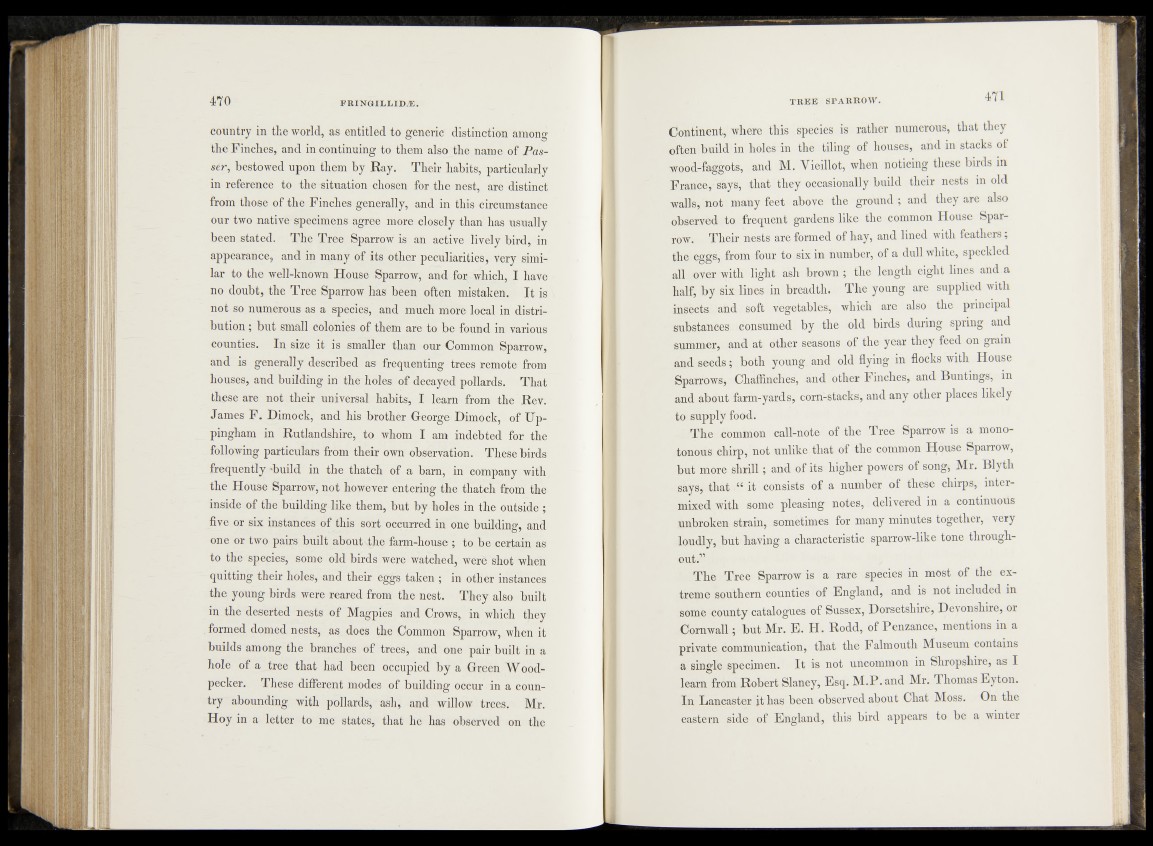
country in the world, as entitled to generic distinction among
the Finches, and in continuing to them also the name of Passer,
bestowed upon them by Ray. Their habits, particularly
in reference to the situation chosen for the nest, are distinct
from those of the Finches generally, and in this circumstance
our two native specimens agree more closely than has usually
been stated. The Tree Sparrow is an active lively bird, in
appearance, and in many of its other peculiarities, very similar
to the well-known House Sparrow, and for which, I have
no doubt, the Tree Sparrow has been often mistaken. I t is
not so numerous as a species, and much more local in distribution
; but small colonies of them are to be found in various
counties. In size it is smaller than our Common Sparrow,
and is generally described as frequenting trees remote from
houses, and building in the holes of decayed pollards. That
these are not their universal habits, I learn from the Rev.
James F. Dimock, and his brother George Dimock, of Uppingham
in Rutlandshire, to whom I am indebted for the
following particulars from their own observation. These birds
frequently ’build in the thatch of a barn, in company with
the House Sparrow, not however entering the thatch from the
inside of the building like them, but by holes in the outside ;
five or six instances of this sort occurred in one building, and
one or two pairs built about the farm-house ; to be certain as
to the species, some old birds were watched, were shot when
quitting their holes, and their eggs taken ; in other instances
the young birds were reared from the nest. They also built
in the deserted nests of Magpies and Crows, in which they
formed domed nests, as does the Common Sparrow, when it
builds among the branches of trees, and one pair built in a
hole of a tree that had been occupied by a Green Woodpecker.
These different modes of building occur in a country
abounding with pollards, ash, and willow trees. Mr.
Hoy in a letter to me states, that he has observed on the
Continent, where this species is rather numerous, that they
often build in holes in the tiling of houses, and in stacks of
wood-faggots, and M. Vieillot, when noticing these birds in
France, says, that they occasionally build their nests in old
walls, not many feet above the ground ; and they are also
observed to frequent gardens like the common House Sparrow.
Their nests are formed of hay, and lined with feathers;
the eggs, from four to six in number, of a dull white, speckled
all over with light ash brown ; the length eight lines and a
half, by six lines in breadth. The young are supplied with
insects and soft vegetables, which are also the principal
substances consumed by the old birds during spring and
summer, and at other seasons of the year they feed on grain
and seeds; both young and old flying in flocks with House
Sparrows, Chaffinches, and other Finches, and Buntings, in
and about farm-yards, corn-stacks, and any other places likely
to supply food.
The common call-note of the Tree Sparrow is a monotonous
chirp, not unlike that of the common House Sparrow,
but more shrill; and of its higher powers of song, Mr. Blyth
says, that “ it consists of a number of these chirps, intermixed
with some pleasing notes, delivered in a continuous
unbroken strain, sometimes for many minutes together, very
loudly, but having a characteristic sparrow-like tone throughout.”
The Tree Sparrow is a rare species in most of the extreme
southern counties of England, and is not included in
some county catalogues of Sussex, Dorsetshire, Devonshire, or
Cornwall; but Mr. E. H. Rodd, of Penzance, mentions in a
private communication, that the Falmouth Museum contains
a single specimen. It is not uncommon in Shropshire, as I
learn from Robert Slaney, Esq. M.P. and Mr. Thomas Eyton.
In Lancaster it has been observed about Chat Moss. On the
eastern side of England, this bird appears to be a winter